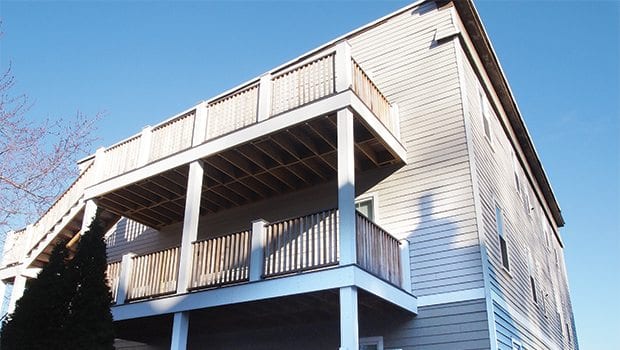Rising Roxbury rents beyond most locals’ means
Extent, amount of affordability falls short

Demonstrations and contentious community meetings over development proposals and city-led neighborhood planning processes underscore the growing tensions fed by Boston-area rents that are increasingly beyond the reach of long-term city residents.
Rents in Roxbury continue to rise past the level that local incomes can support and many say affordability provisions are not well paired to local need.
“I know people who aren’t able to afford rent in the neighborhood, and they’re working two jobs or 40-hours-plus at a $15 or more per hour job,” activist Armani White told the Banner.
Prices and pushout
Vernon Barsatee, short sale negotiator at Exit Bayside Realty, provided the Banner with information on six months of rental deals made in the 02119 zip code, as recorded by the MLS Property Information Network. The information reflects 58 unique properties and two units that were rented twice during that time period.
In ten transactions, one-bedroom units in the sample rented for a median price of $1,550, with the prices ranging from $1,150 to $1,925. The units provided a median living space of 800 square feet. Meanwhile, former City Councilor Chuck Turner estimates Roxbury residents earn on average monthly incomes of about $3,300.
“[If] the cheapest single bedroom you can find is $1,400, $1,500 a month, that’s essentially 50 percent of your income for housing,” Turner said in a Banner phone interview.
The result is many are priced out of their neighborhood and seek affordability in towns further from Boston. Anecdotally, Turner heard of people turning to places such as Fall River and New Bedford for one-bedrooms renting in the range of $600-$800 a month.
“A friend of mine who’s in her 60s and lived in Roxbury all her life just moved to Fall River,” Turner said.
According to the information from Barsatee, of 25 two-bedroom units that rented in the past six months, rents ranged from $1,300 per month to $2,450 per month with a median of $1,800. The median living space size was 900 square feet. For 13 three-bedrooms, rents ranged from $2,000 for a 1-bath apartment to $3,100 for a 2-bath Fort Hill unit, with $2,500 as the median rent. Of nine four-bedroom units, the median rent was $2,750/month, according to the data. Two five-bedroom units in Fort Hill went for $3,800 and $3,200.
It is not only renters moving out. With demand for city housing at a high, many real estate professionals and developers are reaching out to elderly homeowners and offering them high cash sums to sell, White said. Many of these homeowners are taking up the offers, contributing to a demographic shift, he said.
Moving in
Those moving into Roxbury largely are students and young professionals, White and Turner said in separate phone interviews. While newcomers represent a mix of races, most are white, they said. Armani White also cited housing demand from affluent white suburbanites seeking to move into the city.
Students are a lucrative prospect to landlords, given they often are willing to sleep more people per room. Thus a unit that formerly rented for $1,000 to $1,500 per month might earn $2,000 to $3,000 per month from students, Turner said.
Northeastern University’s land-use choices also play a contributing role, White said. When students traditionally look to off-campus housing in their junior and senior years, they are likely to move into the area surrounding their former housing. Many students have been led to move into the neighborhood following NU’s purchase of and development of student housing on Roxbury-located land, White said.
“In areas surrounding Northeastern in Lower Roxbury, the number of low-income African American people has significantly decreased,” White said.
Inserting affordability
The cost of land and construction makes it challenging for developers to turn a profit on housing if they do not offer it at market rate. Government subsidies allow private developers to balance the cost, with the level of subsidy determining the amount of units and extent of affordability.
While community development corporations take on missions of providing for their communities, Turner said recently, they have not always been able to provide the depth of affordability most needed in Roxbury.
According to Massachusetts Association of Community Development Corporations information provided to Turner, between 2010 and 2015 CDCs created 125 rental units in mixed-use developments in Roxbury. Of these, 36 were affordable for those with incomes of up to 30 percent AMI ($23,600 for a family of two, according to Affordable Housing Online). Another 81 units were priced for those making 31 percent to 60 percent AMI (up to $47,100 for a family of two). Three units were offered for those making 61 percent to 80 percent AMI and five units for those earning above or at 81 percent AMI.
During that time period, MACDC members created 523 more units in housing-only developments in Roxbury, of which 26 were ownership units and 497 rental. Of the 523 units, 100 were designated for those making up to 30 percent AMI, 376 for those making 31 percent to 60 percent AMI, 32 for those making 61 to 80 percent AMI and 15 unit for those making up to 81 percent AMI.
City-owned land represents another resource that can be tapped to address affordable housing needs. While Mayor Martin Walsh’s administration is working toward its goal of creating 53,000 new units to ease housing pressures, White and Turner say there is need for greater action.
Turner said the city should take a firmer stance in the face of powerful need. He recommended that anytime city-owned land is used for housing construction, the city require that one third of the units are provided for low incomes, one third for moderate incomes and one third at market rate.
“We have a situation where the vast majority of the people in the community have incomes that don’t allow them to economically rent units based on the formula being used,” he said. “In any community in Boston where rents are moving up more quickly than income and displacement is happening because of that, you’d assume that the use of city land would act as a mitigating force trying to balance the negative economic pressures of the private market.”






